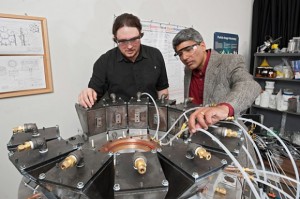Nice video, talks about what matter really is from a quantum level:
The PowerPot
 Here’s a cool gadget that’s a bit counter to the ‘keep it simple’ philosophy. It’s a thermoelectric device buried under a pot, designed for backpacking use to charge your iPhone and other gadgets (you’re not really keeping it simple if you’re depending on those while backpacking!). So if you really can’t leave those gadgets behind when backpacking, this is the perfect solution to ensure they’re always fully charged. The alternative would be solar panels, though if you assume that you’ll be making a campfire regardless, then this might be more reliable than counting on sunshine. The inventors are currently seeking funding at Kickstarter; cost is $125.
Here’s a cool gadget that’s a bit counter to the ‘keep it simple’ philosophy. It’s a thermoelectric device buried under a pot, designed for backpacking use to charge your iPhone and other gadgets (you’re not really keeping it simple if you’re depending on those while backpacking!). So if you really can’t leave those gadgets behind when backpacking, this is the perfect solution to ensure they’re always fully charged. The alternative would be solar panels, though if you assume that you’ll be making a campfire regardless, then this might be more reliable than counting on sunshine. The inventors are currently seeking funding at Kickstarter; cost is $125.
Sequence a human genome in 24 hours!
 The first human genome to be sequenced took about thirteen years, and cost a few billion dollars. A new product from Life Technologies has dramatically improved upon that, offering sequencing of an entire human genome sequence in under a day and at a cost under $1000! The machine itself costs around $150k, so would pay for itself pretty quickly (current costs for sequencing a genome are around $10k+). We’re entering a new era of medical care enabled by information like this, and it’ll be exciting to watch how these technologies are used (such as in preventative care, also with targeting medications).
The first human genome to be sequenced took about thirteen years, and cost a few billion dollars. A new product from Life Technologies has dramatically improved upon that, offering sequencing of an entire human genome sequence in under a day and at a cost under $1000! The machine itself costs around $150k, so would pay for itself pretty quickly (current costs for sequencing a genome are around $10k+). We’re entering a new era of medical care enabled by information like this, and it’ll be exciting to watch how these technologies are used (such as in preventative care, also with targeting medications).
(via Core77)
An alternate possibility for Google AR glasses
Yesterday I (and about a million other websites) posted a video of Google’s concept Augmented Reality (AR) glasses. It was pretty similar to other AR systems (here and here, for example) so in that respect was nothing new. I found it interesting how much more publicity that video gained, perhaps because of its source? Well no matter. I really had to share an funny video that someone made to show a possible downside of this AR glasses technology. Hilarious, yet so true…and it shows some of the real challenges that designers of these AR systems will be facing.
Self-sustaining solar-powered Hydrogen generator
 Engineers at the University of Delaware have developed a prototype hydrogen generator that has the potential to revolutionize solar energy production. Solar thermal energy is used to vaporize zinc oxide powder. This gas is then reacted with water to produce hydrogen gas and zinc powder (which can then be fed back into the system). The shortcoming of any solar energy system is energy storage, and a system that produces hydrogen gas solves that as the gas can be stored for later conversion to electrical power in a fuel cell.
Engineers at the University of Delaware have developed a prototype hydrogen generator that has the potential to revolutionize solar energy production. Solar thermal energy is used to vaporize zinc oxide powder. This gas is then reacted with water to produce hydrogen gas and zinc powder (which can then be fed back into the system). The shortcoming of any solar energy system is energy storage, and a system that produces hydrogen gas solves that as the gas can be stored for later conversion to electrical power in a fuel cell.
The system requires further testing but it’s off to a promising start! Read more at Physorg.


